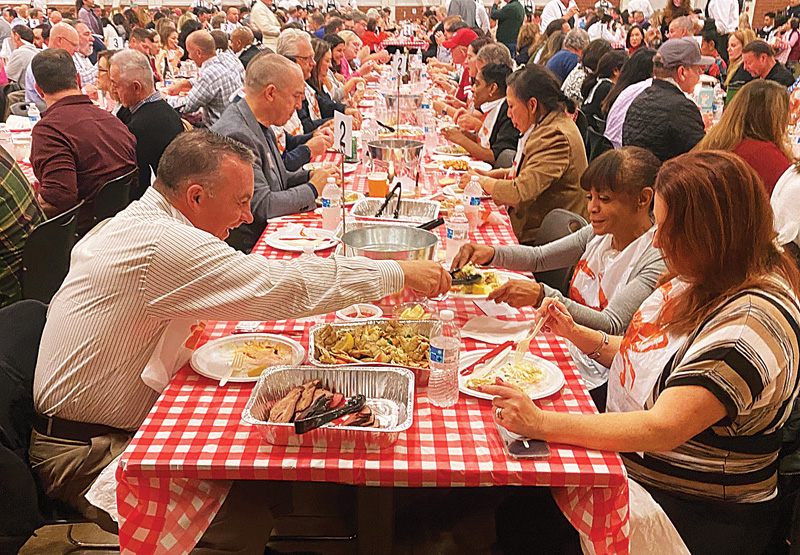Crackin’ good times continue for crab feeds amid mounting challenges

CONTRA COSTA COUNTY, CA (Feb. 19, 2024) — The early part of each new calendar year is marked by the return of crab feed season, when friends and family don flimsy bibs and dive into trays stocked with delectable Dungeness crustaceans.
We’re in the thick of the season for the notable fundraiser for schools, nonprofits and service organizations – with weekends chock-full before winding down in March.
Armed with the requisite crab cracker and pick, Gus Kerry is a regular patron of the De La Salle Crab Feed.
“I don’t normally eat crab when I go out to a restaurant,” he said. “So, going to this crab feed is where I will get it.”
The chance to reconnect with old acquaintances in the school community also makes the crab feed experience special.
For Andrea Saunders, crab feeds are a reminder of her brother-in-law, a fisherman, and the hard work that goes into making these events possible.
Issues with pricing, season start
Their popularity has endured despite the unpredictability of crabbing seasons – the official start for commercial fishermen wasn’t until Jan. 18 this year – and what price crab feed organizers ultimately shell out when preparing for their events.
Even with the late start, this year is shaping up to have enough good quality crab available at a price that hasn’t been a shock to organizers, according to Diane Van Iderstine of San Ramon-based Cali Crab Feed. She noted that the price per pound was $1.50 less than last year.
The average crab feed includes about 1,200 pounds, approximately three pounds per attendee. “Now they have more going to their charity and less money going to crab,” she said.
After the Dungeness supply along the local California coast is exhausted, Van Iderstine and other suppliers shift gears to bring crab down from Crescent City and Fort Bragg. That means adding new transportation costs.
Making other adjustments
Ticket prices for most crab feeds are up this year to offset the cost of the cleaned and cracked crab and other factors that go into the economics of putting on the event. The upfront adjustment ensures that financial support for programs, activities or services doesn’t suffer.
The St. Demetrios Greek Orthodox Crab Feed, back after a hiatus caused by the COVID Pandemic, is among eight on the calendar just in Concord and Pleasant Hill during February. And when considering those scheduled in surrounding communities, that number more than doubles.
“One of the reasons for the increase in the price is definitely the cost of fresh crab, but the cost of goods has also increased by as much as 30%,” said Violetta Hantziantonakis, the church’s 2024 crab feed co-chair.
“Rental fee of Centre Concord was increased,” she added. “We were also hit with an unexpected cost for security, which has not been a requirement in the past.”
St. Demetrios is among the many organizations that have started including other entrees to further entice patrons.
“We are offering half chicken in lieu of crab for those who do not eat crab or are allergic to crab but want to attend with their family or friends,” Hantziantonakis said.
Another new attraction that didn’t cost St. Demetrios’ organizers a penny was the inclusion of live entertainment.
Dori Freitas, chair of the Concord High School Athletic Boosters Crab Feed, noted similar challenges that prompted increased ticket prices. However, inclusion of drink tickets with each feed ticket, offering non-seafood options and efforts to keep auction items fresh are strategies that have helped keep interest robust.
“We have many CHS alumni come out for the event. We are very close to our pre-pandemic attendance,” she said.
Scaling back another option
Gigi R. Crowder, executive director of NAMI Contra Costa (the National Alliance of the Mentally Ill), said her March fundraiser is putting the emphasis back on “fun.”
As opposed to crab feed organizers who added more to their events, Crowder went the other way and cut back.
“We could have raised more money but didn’t want to exhaust our staff and volunteers,” she said. “We are in a pretty good spot financially.”
When the prospect of not holding the crab feed was on put on the table, Crowder says she heard a chorus of “We just want to eat the crab.”
The supplier for the NAMI event advised a $5 increase in the price of tickets to account for what he was passing along to the organization.
As for the timing of their event at the end of the season, Crowder said March works to their advantage due to a lot of other programming in February.
First Tee of Contra Costa was among those on the crab feed circuit when action was just kicking off in January. After the toll that the pandemic took on crab feeds, executive director Jamie Maddox is pleased with this year’s attendance. The sit-down shindig followed two drive-through events to sustain fundraising during COVID.
“It is not the biggest crab feed,’’ he conceded. “We just try to keep it simple.”
The emphasis is on the kids who do the serving and enjoying the camaraderie, he continued, citing the focus on education and golf.
Still, it comes at a cost, like for security and venue rent.
“Everything is more expensive,” Maddox said.

David Scholz
David Scholz is back in journalism as a freelance writer and photographer after nearly two decades in education. Prior to moving into teaching in 2000, he worked as a full-time journalist since 1988 for rural community and small daily newspapers in Central Ohio and Northern Nevada, and later in California with The Business Journal in Fresno and dailies in the Bay Area, including The Oakland Tribune and The San Francisco Chronicle. More recently Scholz also worked in an editing, writing, and page layout role with the Rossmoor News.
